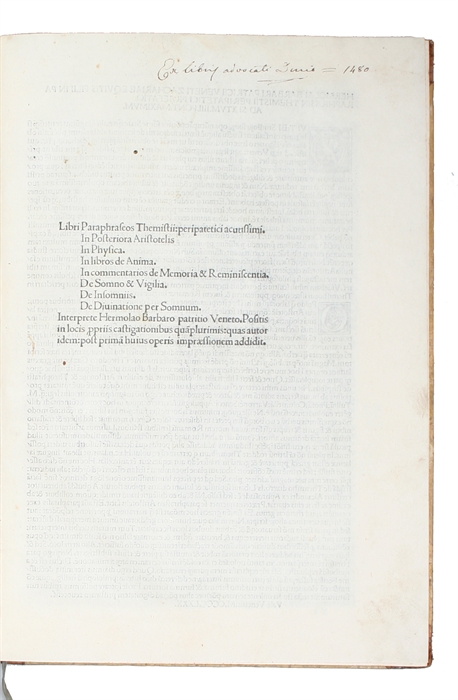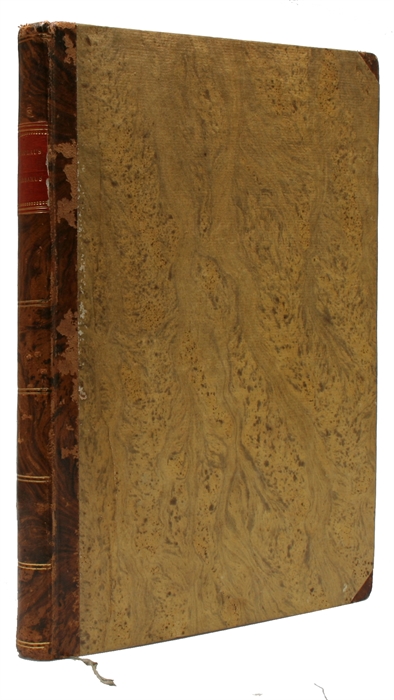A KEY PUBLICATION OF THE RENAISSANCE
THEMISTIUS PERIPATETICUS (THEMISTIOS).
Libri Paraphraseos. In Posteriora Aristotelis. In Physica. In libros de Anima. In commentarios de Memoria & Reminiscentia. De Somno & Vigilia. De Insomniis. De Diuinatione per Somnum. Interprete Hermolao Barbaro...
[On the final colophon:] Venice, Bartholomeus de de Zanis for Octavianus Scotus, 1499. [at the end of first leaf and of each section: Vale. Venetiis. 1480, except for the second last (de Insoniis, which says: Vale. Venetiis. 1478).
Small folio. Nice, elegant late 18th century half calf. Binding with a few traces of wear. A very nice, clean, and fresh copy with just a bit of light dampstaining to upper margin of about 20 leaves. Numerous pretty, woodcut initials throughout. Woodcut printer's devise to colophon. Last leaves with tiny, barely noticeable wormhole. Contemporary handwritten inscription to title-page: "Ex libris advocati Dunis = 1480". (1), 115 ff. (pagination erroneous at end: 113, 116, 114). Without final blank.
The very rare second printing of Ermolao Barbaro's seminal Latin translation of Themistios' paraphrases of Aristotle's "Posterior Analytics", "Physics", "De Anima", "On Memory", and "On Dreams", a groundbreaking key text of the Renaissance, "which opened a new period in the interpretation of the Greek philosopher [i.e. Aristotle]" (Lohr, p. 25). The work was partly responsible for the development of Renaissance Aristotelianism and thus Renaissance thought in general. The combination of the fact that we here have the paraphrases by one of the greatest ancient Greek commentators of the key texts of the most significant philosopher of all times, rendered into Latin by perhaps the most significant translator of the period and printed at the most crucial time for the development of early modern thought, makes this one of the most significant philosophical publications of the Renaissance. There can be no doubt as to the influence that the present publication came to have on the development Renaissance philosophy.
"The publication of Barbaro's translation of Themistius inaugurated a new period in the study of Aristotelian philosophy. In his version of Themistius' "Paraphrases" we encounter not simply a translation occasioned by contemporary controversies, as was often the case in the Middle Ages. Rather, Barbaro's version brings together a corpus of the commentaries of Themistius on Aristotelian philosophy: the "Posterior Analytis", "Physics", "De anima" and "Parva naturalia". (Lohr, p. 26).
The first printing of the work appeared in 1480 (the same year stated at the end of each section in the present edition), and in 1499 this second printing appeared. Both printings are of the utmost scarcity and almost impossible to find. After these two incunable-editions, at least 9 new printings appeared before 1560, bearing witness to the great impact of the text, and in 1570 Hieronymus Scotos printed a new edition.
"With reference to those works of Aristotle which were and remained the center of instruction in logic and natural philosophy [i.e. The Posterior Analytics, Physics, etc.], the most important changes derived from the fact that the works of the ancient Greek commentators became completely available in Latin between the late fifteenth and the end of the sixteenth centuries and were more and more used to balance the interpretations of the medieval Arabic and Latin commentators. The Middle ages had known their works only in a very limited selection or through quotations in Averroes. Ermolao Barbaro's complete translation of Themistius and Girolamo Donato's version of Alexander's "De Anima" were among the most important ones in a long line of others. When modern historians speak of Alexandrism as a current within Renaissance Aristotelianism that was opposed to Averroism, they are justified in part by the fact that the Greek commentators, that is, Alexander and also Themistius, Simplicius, and many others, were increasingly drawn upon for the exposition of Aristotle." (Kristeller, p. 45).
"Equally important [as the recovery of Aristotle's "Mechanics" and "Poetics"] for the continued growth of the Peripatetic synthesis was the recovery and diffusion of the Greek commentaries on Aristotle... The most important of the two dozen commentators were Alexander of Aphrodisias, Ammonius, Simplicius, Themistius, and John Philoponus. Of these five, only Alexander and Themistius were Aristotelians..." (Copenhaver & Schmitt, p.68).
Already in the Middle Ages, scholars had been aware of and used commentaries on and paraphrases of the key texts of Aristotle, but their knowledge of this was primarily based on some Latin translations and allusions, fragments, and summaries in the writings of the Muslim philosophers, e.g. Averroes. But with the emergence and translations into Latin of the ancient Greek commentators [Alexander and Themistios being the primary ones] and their paraphrases of Aristotle's texts, the Renaissance came to discover an Aristotle that would influence almost all thought of the period. The ancient Greek commentators not only had a much more thorough knowledge of classical Greek thought than would have been possible for a medieval writer, but they also had access to works that were later lost and through these ancient commentators rediscovered in the Renaissance. By the middle of the 16th century, almost all of these texts had been printed in both Greek and Latin, and these publications were of the utmost importance to the development of almost all Renaissance thought. "Their recovery, publication, and translation took some time, but almost all circulated in Greek and Latin by the 1530'ies. They do not cover all of Aristotle, but several treat such key texts as the "Organon", the "Physics", and "De anima", thus making them useful ammunition in such controversies as the immortality dispute provoked by Pietro Pomponazzi and his colleagues." (Copenhaver & Schmitt, p. 69).
Among the most important texts in this tradition that influenced all thought of the era, were Themistios' paraphrases of Aristotle's seminal texts, in particular "De Anima", "Posterior Analytics", and Book Lambda (XII) of the "Metaphysics".
"We possess part of his [Themistios'] early work, his "Paraphrases of Aristotle", the portion still extant being a somewhat prolix exposition of the "Later Analytics", the "Physics", the "De Anima", and some minor treatises." His paraphrase of the "Metaphysics", Book "lambda" [i.e. XII], was translated into Arabic (in century IX), and hence into Hebrew (1255), and Latin (1576)." (Sandys, I:352).
There can be no doubt about the groundbreaking character of Hermolao Barbaro's translation into Latin of almost all of Themistios' paraphrases of Aristotelian texts. Not only was Themistios considered one of the most important renderers of Aristotle's text, but Barbaro was perhaps the most influential translator of the time. His translation of Themistios' paraphrases came to dominate, directly or indirectly, almost all Aristotelian thought of the high Renaissance (from late 15th century) and he was responsible for many of the most important and influential positions on the seminal question of the immortality of the soul that dominated philosophical thought at the time. "Through the first two-thirds of the fifteenth century, Pomponazzi's predecessors at Padua seem not to have used the ancient commentators, but philosophers of the next generation - most notably Nicoletto Vernia and Agosto Nifo - began to consult them in new translations by Ermolao Barbaro and others. Barbaro's charge that Averroes had lifted his doctrines of the soul from the commentators surely helped excite interest in them." (Copenhaver & Schmitt p. 69).
See: Kristeller, Renaissance Thought and its Sources, 1979; Copenhaver & Schmitt, Renaissance Philosophy, 1992; Charles C. Lohr, "Latin Translations of the Greek Commentaries on Aristotle", in: Humanism and Early Modern Philosophy, Edt. byKraye and Stone, 2000.
Graesse VII:112 (erroneously stating 1491 in stead of 1499); Brunet V:778; Hain-Copinger: 15464.
Order-nr.: 42313



